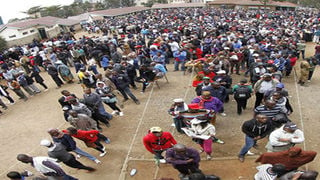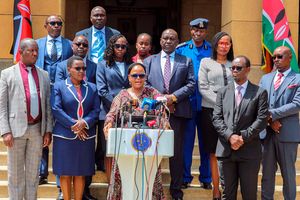
Voters queue to cast their ballot at Moi Avenue Primary School on August 8, 2017.
| File | Nation Media GroupPolitics
Premium
Time for vote hunt as IEBC targets 6m youth
The race to the August 2022 General Election gains fresh momentum in just over two weeks, when the electoral commission kicks off mass voter registration targeting six million youths who have attained voting age in the past five years.
The Independent Electoral and Boundaries Commission (IEBC) has earmarked the month of October for signing up new voters, opening a new battle frontier for political parties in the 2022 race for State House as well as other electoral seats.
“The IEBC targets at least six million new voters at the county assembly ward level and we urge all eligible Kenyans who have not registered to turn out up in large numbers and register,” said IEBC chairman Wafula Chebukati while announcing the registration drive.
Recent voter registration patterns have been used to predict presidential election outcomes with reasonable accuracy, given Kenyans’ inclination to vote as regional blocs.
So integral is the upcoming voter registration drive that Orange Democratic Movement (ODM) leader, Raila Odinga, has pegged his decision on whether or not to vie for the top job, the fifth in an illustrious career spanning over three decades, on the youths’ turnout in his backyard.
"I cannot vie if my people have not registered for IDs and voters’ cards. I will first gauge the number of people who are registered before I make my announcement on the presidential race; so take this matter seriously. I have seen where we are going and mastered all the ways to manoeuvre through the journey. Nyanza residents should support me in this journey by registering as voters. My aspirations depend on voter registration,” Mr Odinga said in Rangwe, Homa Bay County, on Saturday.
While Kenya has a total of 9.2 million eligible new voters, the IEBC says it is seeking to enlist only six million of those who had either not turned 18 years by 2017 or those who had attained the age but failed to register in the last General Election.
The registration of six million new voters will raise Kenya’s total voters register to 23.6 million, up from 19.6 million in 2017.
To cater for the projected increase in voter numbers, and the requirement that no polling station will have more than 700 voters, the IEBC estimates that Kenya will have 53,000 polling stations in 2022, up from the 40,883 in the 2017 poll.
The voters roll estimate is based on the assumption that all eligible voters will enlist, and does not factor deaths.
It includes some 5.2 million youth who will have attained voting age by 2022 and an additional four million people eligible to vote in 2017 but who were not registered as voters, according to an analysis of the 2019 census and 2017 voter registration numbers.
With 809,583 total potential new voters, Nairobi, currently with 2.25 million registered voters, is potentially the richest hunting ground for politicians to snap up in the planned registration drive.
Others in the top 10 of potential new voters are Kiambu (489,361), Nakuru (397, 133), Bungoma (371, 241), Kakamega (337, 091), Machakos (337, 993), Kilifi (331, 889), Turkana (316, 705), Meru (302, 929) and Uasin Gishu (285, 456).
The Maa counties of Kajiado and Narok have 272,033 and 249,756 potential new voters in 2022, respectively, while Mombasa, Trans Nzoia, Wajir, Makueni, Kitui, Migori, Garissa and Kisii follow, in that order, having between 240,000 eligible new voters and 200,000.
Kwale, Nandi, Bomet, Kericho, Busia, Kisumu, Homa Bay, Baringo, Mandera, Murang’a, Siaya, West Pokot, Embu and Marsabit can enlist up to between 200,000 and 100,000 new voters.
President Uhuru Kenyatta’s restive political backyard of Mt Kenya, slowly taking shape as the country’s biggest swing vote in 2022, has a potential of 5.9 million new voters by next year, while Deputy President William Ruto’s Rift Valley backyard could have a total of 7.448 million votes.
This includes Nakuru’s 1.346 million possible new voters, as well as Laikipia’s 323,455, Trans Nzoia’s 586, 481, Kajiado’s 683,226, Narok’s 591,486, Turkana’s 508,140, and Samburu’s 158,331, all seen as battlegrounds in the expansive 14-counties region.
The Nyanza counties of Kisumu, Siaya, Homa Bay, Migori, Kisii and Nyamira could have a total of 3.641 million giving a glimpse of Mr Odinga’s base numbers.
Based on these projections of total possible votes by 2022, Nyanza, Western and Coast could collectively have 9.1 million voters next year—all seen as Mr Odinga’s bases based on the 2007, 2013 and 2017 polls, but with Dr Ruto has since made some inroads in the region while Amani National Congress (ANC) leader Musalia Mudavadi also aims to slice up a chunk of the Western vote in his second attempt at the top job.
Keen to attain the most numbers in the planned mass registration drive, ODM director of political affairs Opiyo Wandayi yesterday said the party was pulling all stops to mobilise the youths.
“Elections is all about numbers and every political party worth its salt will be monitoring this exercise keenly. How we shall approach it ourselves is a strategic question that cannot be a subject of public debate,” said Mr Wandayi, who is also Ugunja MP.
Mr Wandayi demanded a fair process.
“Voting is a civic duty for every citizen. Therefore, nobody should feel disenfranchised in any way. The IEBC should provide adequate time for voter listing. The government should also fast track the processing of issuing identity cards to the millions of youth who have applied for them to enable them participate in this crucial exercise,” he said.
Murang’a senator Irungu Kang’ata, on the other hand, said DP Ruto’s political wing was planning to target the youth, particularly those between 18 and 25 years, and whom they see as the biggest swing vote in the 2022 polls. A total of 5.2 million youth who were not eligible to vote in 2017 have now attained voting age.
“We have activated our machinery countrywide to mobilise our supporters to register as voters. Hustler movement is powered by youths hence it’s important to ensure they are registered as voters particularly the 18 to 25 age bracket. We have roped in influencers who wield clout among the youth to help our voter registration drive. They include social media influencers,” said Mr Kang’ata yesterday.
The ANC party leader, Mr Mudavadi, wants the IEBC to assure Kenyans of the credibility of the process, alleging plans to use Huduma Namba as the voting document instead of the gazetted identification numbers, which is set to be phased out over time.
“Our electoral laws recognize the national identity card or the passport as documents of voting. No law has been changed to allow any other document to be used,” Mr Mudavadi said in Murang’a on Sunday.
In Western, former Trade minister Mukhisa Kituyi, Senate Speaker Ken Lusaka and Bungoma governor Wycliffe Wangamati this weekend asked residents to come out in large numbers to enlist as voters.
“As Luhyas, we have got the weapon. Let’s turn out in large number and register as voters. This way we can have a bargaining power as a community and join hands with other communities to march to State House. We can’t think of winning the presidency if ourselves as a community isn’t registering,” said Dr Kituyi at Khamoto Primary School, Maraka Ward in Webuye East.
Mr Lusaka said Luhyias are the second-biggest voting bloc after Mt Kenya, and that should count for something in next year’s polls.
“By registering as voters the youth, who are the majority, will have a big and direct say in determining their future by electing leaders of their choice,” said Mr Lusaka.
Tharaka Nithi Governor Muthomi Njuki yesterday appealed to the youth to register as voters, even as he complained that most of them had not acquired identity cards.
The county has 213,154 voters with Chuka/Igambang’ombe leading with 76,486 voters followed by Maara with 68,729 and Tharaka at 67,939.
The county boss is facing stiff competition from Senator Kithure Kindiki, Chuka University Vice Chancellor Erastus Njoka, National Museums of Kenya Director General Dr Mzalendo Kibunjia and the clerk of the Machakos County Assembly, Gitari Mbiuki.
Additional reporting by Brian Ojamaa and Alex Njeru
Total potential new voters by county (9.251 million)
The number of new voters IEBC is targeting in new registration: 6,000,0000.
Total number of voters in 2017: 19, 611, 433
1. Nairobi 809,583
2. Kiambu 489,361
3. Nakuru 397,133
4. Bungoma 371,241
5. Kakamega 337,091
6. Machakos 337,993
7. Kilifi 331,889
8. Turkana 316,705
9. Meru 302,929
10. Uasin Gishu 285,456
11. Kajiado 272,033
12. Narok 249,756
13. Mombasa 234,741
14. Trans Nzoia 228,859
15. Wajir 225,671
16. Makueni 220,095
17. Kitui 217,524
18. Migori 214,973
19. Garissa 211,669
20. Kisii 209,377
21. Kwale 199,428
22. Nandi 191,463
23. Bomet 188,865
24. Kericho 171,268
25. Busia 163,075
26. Kisumu 163,056
27. Homabay 151,054
28. Baringo 138,312
29. Mandera 131,073
30. Muranga 126,946
31. Siaya 124,546
32. West Pokot 123,504
33. Embu 108,716
34. Marsabit 102,082
35. Nyamira 90,002
36. Vihiga 87,162
37. Kirinyaga 84,763
38. Elgeyo Marakwet 82,629
39. Nyeri 77,475
40. Laikipia 76,968
41. Samburu 75,544
42. Nyandarua 74,866
43. Isiolo 71,978
44. Taita Taveta 69,063
45. Tharaka Nithi 47,896
46. Tana River 44,771
47. Lamu 18,179
Totals 9,251,763





